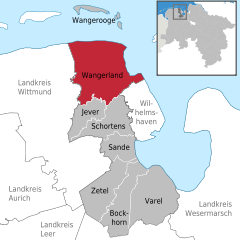Wangerland
| Wangerland | ||
|---|---|---|
| ||
 Wangerland | ||
Location of Wangerland within Friesland district 
 | ||
| Coordinates: 53°39′N 7°57′E / 53.650°N 7.950°ECoordinates: 53°39′N 7°57′E / 53.650°N 7.950°E | ||
| Country | Germany | |
| State | Lower Saxony | |
| District | Friesland | |
| Government | ||
| • Mayor | Björn Mühlena (Ind.) | |
| Area | ||
| • Total | 176 km2 (68 sq mi) | |
| Population (2015-12-31)[1] | ||
| • Total | 9,213 | |
| • Density | 52/km2 (140/sq mi) | |
| Time zone | CET/CEST (UTC+1/+2) | |
| Postal codes | 26434, 26441 (Groß Hauskreuz) | |
| Dialling codes | 04463, 04464, 04461, 04425, 04426 | |
| Vehicle registration | FRI | |
| Website | www.wangerland-online.de | |
Wangerland is a municipality in the district of Friesland, Lower Saxony, Germany. It is situated on the North Sea coast, approximately 20 km northwest of Wilhelmshaven, and 10 km north of Jever. Its seat is in the village Hohenkirchen.
History
First settlements are dated on the 2nd century B.C.
Subdivision
The municipality consists of the following villages: Altgarmssiel, Förrien, Friederikensiel, Hohenkirchen, Hooksiel, Horumersiel, Middoge, Minsen, Neugarmssiel, Oldorf, Schillig, Tettens, Waddewarden and Wiarden.[2]
References
External links
- Official site (German)
- Churches in Wangerland (German)
This article is issued from Wikipedia - version of the 5/26/2016. The text is available under the Creative Commons Attribution/Share Alike but additional terms may apply for the media files.
